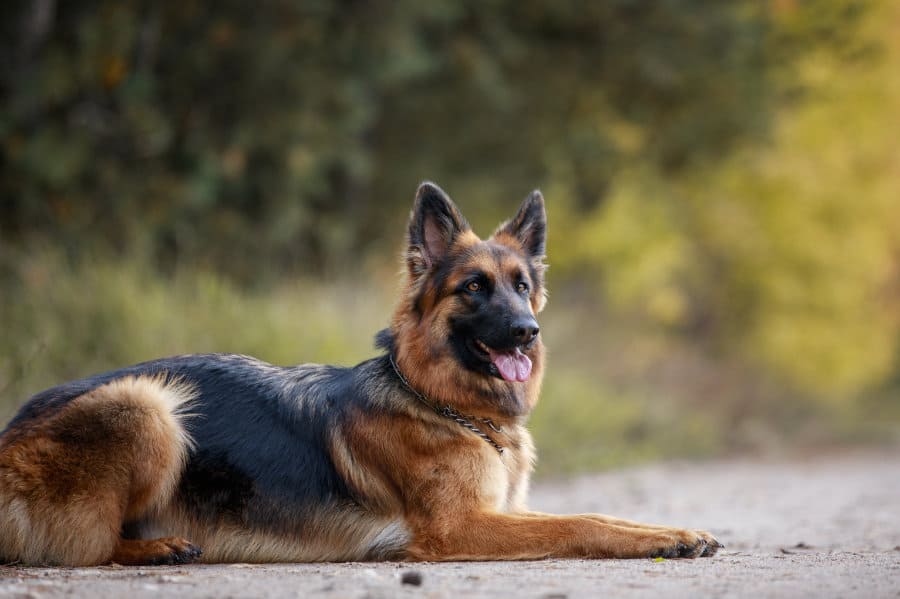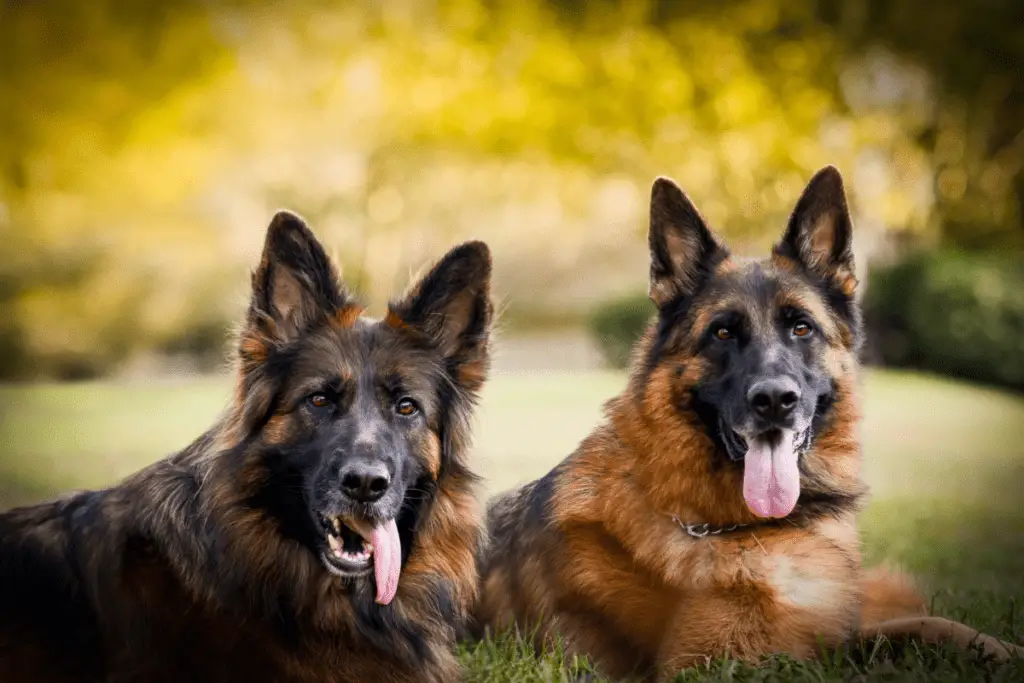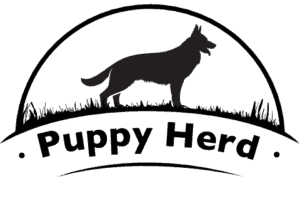German Shepherds typically have thick double coats and are known for constantly shedding. If your German Shepherd’s hair isn’t growing as it should, or you just want to encourage healthy regrowth after a bad trip to the groomers, there are several things you can do.
To get your German Shepherd’s hair to grow, you need to wash and brush it regularly but not too often. Providing your German Shepherd with a healthy diet is also essential to hair growth. There are several health problems, such as alopecia, to look out for if you notice hair loss in your dog.
Read on to learn more about German Shepherd’s hair, how to properly care for their hair, steps to take to encourage growth, and possible signs that your German Shepherd might have a health issue.

Long-Haired vs. Short-Haired German Shepherds
German Shepherds can have different hair types, or in this case, coat types. Some German Shepherds have “long” hair, while most have short hair. Although the hair is different on each German Shepherd, caring for their fur is relatively the same.
- Long hair: Long-haired German Shepherds are very rare, and, according to the American Kennel Club, they’re considered a fault among German Shepherds. Long-haired German shepherds have a very thin undercoat, and it’s so fine that many people consider them only to have one coat. Their coat differs from the short-haired German shepherds because it grows up to two inches and is silky.
- Short hair: Short-haired German shepherds are the most commonly seen type. Short-haired German shepherds have a double coat which is close and dense with a thick undercoat. Short-haired differs from long-haired because their hair is short, thick, and rough.
Bathe Your German Shepherd
One of the best ways to ensure hair growth in German Shepherds is to bathe them regularly. However, you don’t want to wash them too often, as doing so can cause skin irritation.
How Often Should I Bathe My German Shepherd?
Depending on the amount of time your German shepherd spends outside will determine how often you should bathe it. Typically, German Shepherds only need to be washed 4-5 times per year. Because their coats are so thick, they build up natural oils that are healthy for their skin. Therefore, too frequent bathing strips away those beneficial oils.
If your German Shepherd is outside more often than usual and gets dirty quickly, then bathing every two months or so is acceptable for their skin.
Why Does Bathing Help My German Shepherd’s Hair Grow?
Oils are great for your dog’s coat. Too much oil, however, can cause skin problems and prevent hair growth.
If you haven’t bathed your German Shepherd in a while, its coat probably has excess oil buildup. Bathing your dog will help clean out its fur and pores, which will allow the hair to grow once again.
Best Way To Bathe A German Shepherd
Bathing a dog can be a harrowing experience. German Shepherds are big dogs, so getting them into a bathtub or a kiddie pool might end up in you getting wetter than your dog. If you have thoroughly trained your dog or introduced your German Shepherd to baths at a young age, bathing shouldn’t be too difficult.
However, if not, slowly introducing your German Shepherd and training as you do so is the best course of action. Eventually, your dog should get used to bathtime.
If you’re looking for excellent dog shampoo, the FUrminator deShedding Ultra Premium is highly recommended. This shampoo is great for German Shepherds because it helps with shedding and promotes a healthy coat and skin.

Brush Your German Shepherd
Brushing your German Shepherd’s hair is a great way to promote healthy skin and encourage hair growth. Because of the oils that build up in hair, brushing distributes these oils all over.
How Does Brushing Help My German Shepherd’s Hair Grow?
While distributing oils all over is great for promoting hair growth, it’s also important because of how much German Shepherds shed.
Shedding is a natural cycle among dog breeds. Deshedding German Shepherds will help remove that extra buildup of hair that they’re carrying around and allow new hair growth to occur.
Deshedding is especially important for German Shepherds because of their naturally thick coats. So, regularly brushing your dog is essential. It’s best to brush your dog at least 3 to 4 times a week for 10 minutes each session.
However, similar to bathing, if your German Shepherd is outdoors often, brushing more might be preferred, especially if you notice more shedding. Distributing oils and removing shedding hair will help your German Shepherd’s hair grow.
If you’re looking for an excellent deshedding brush, the FURminator Undercoat Deshedding Tool is perfect for the job. This brush is great for de-shedding, and it’s available for long and short coats.
Provide Your German Shepherd With A Healthy Diet
A healthy diet is essential to anyone’s overall health. Without a healthy diet and the proper nutrients, it will stunt hair growth. If you notice your German Shepherd’s hair isn’t growing as it should, one of the first things you should look at is its diet.
Many commercial dog foods don’t have all the nutrients dogs need every day. Therefore, you might be depriving your German Shepherd of essential nutrients that it needs for proper hair growth.
Zinc deficiency, for instance, is common among dogs. Zinc is an essential element for the skin in everyone, not just dogs.
Zinc deficiency causes hair loss, skin ulcers, and areas of skin thickening and cracking in dogs. Protein and fat content are also crucial in a dog’s diet. Without adequate protein and fat, a dog’s coat can become brittle and even result in hair loss.
If you don’t think your German Shepherd is getting enough nutrients and that may be causing hair loss or no hair regrowth, speak to your Vet and see if the Zesty Paws Salmon Fish Oil Omega 3 For Dogs is right for your dog. This product is excellent for supporting healthy skin and coat in dogs because of the Omega 3 fatty acids, and it even comes in liquid form, which makes it easier to serve it to your dog mixed with food.

Possible Health Issues To Look Out For
No new hair growth or hair loss can be due to many more severe health problems. If your dog just got a bad haircut and you want its hair to grow faster, this isn’t something to worry yourself over. However, if you’re noticing hair loss in your dog, it’s crucial to find out what could be wrong.
Alopecia
Alopecia, characterized as a varied or symmetrical hair loss, is usually seen as missing patches of fur, and the skin can become red and inflamed. One of the leading causes of alopecia is mange.
There are different levels of severity to look out for when it comes to alopecia. If you notice hair loss in multiple areas with scaling on the patches, this is a more severe case and should be looked at by a vet.
Hypothyroidism
Hypothyroidism in dogs, is when the immune system decides the thyroid is abnormal or foreign and attacks it.
While hair loss is a sign of hypothyroidism, other symptoms include excessive weight gain, pigmentation of the skin, and lethargy. If you notice any of these signs along with hair loss, take your German Shepherd to the vet to get checked out.
Many other major health issues can lead to hair loss in dogs, so it’s essential to be vigilant and ask your vet if you have any concerns.
Final Thoughts
If your German Shepherd is having trouble with hair regrowth or hair loss problems, taking simple steps such as bathing, brushing, and paying attention to its diet can encourage hair production. Before taking these steps, it’s essential to learn what type of hair your German Shepherd has and how often it spends time outside.
While numerous health problems lead to hair loss in dogs, these problems will be noticeable and easily treated by a veterinarian.
